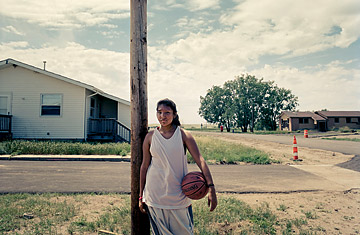
Spirit Grass, 13, is part of a family of six in Thunder Butte, S.D., who until recently survived on $3,500 a year.
THERE IS NO SINGLE ARCHETYPE OF AMERICA'S POOR.
They are low-wage workers, single mothers, disabled veterans, the elderly, immigrants, marginalized factory workers, the severely mentally ill, the formerly incarcerated, the undereducated and the fallen middle class. They live in Appalachia and the inner city and the wealthiest suburbs.
And they are growing in number. The poverty line is set at an annual income of $22,314 for a family of four. Last year, 46.2 million Americans lived below it, the most since the U.S. Census Bureau began keeping track in 1959. The current poverty rate of 15.1% matches brief peaks after recessions in the early 1980s and '90s but otherwise hasn't occurred since 1965.
It would be nice to think that this problem will disappear once the economy turns around. That almost certainly won't happen. While the Great Recession and its double-digit unemployment have driven many families below the poverty line, the poverty rate has broadly been on the rise since 2000, which means that for years, it was growing along with the economy. That's a historical anomaly and an indication that forces much deeper than the unemployment rate are at play.
What does it mean to be poor in the U.S.? Not always what you think. It can't be measured solely by material deprivation: poor families might well own a car or subscribe to cable TV. That paradox stems in part from the inadequacy of using a single year of income to gauge poverty and not factoring in savings or expenses. A more realistic reckoning would account for a family's ability to make ends meet--to pay the electricity bill and put food on the table--and the Census Bureau has been developing standards along those lines. But there's also the fact that, the $22,314 line notwithstanding, poverty is often a relative phenomenon, with indicators less absolute than contextual. Lacking indoor plumbing didn't signify poverty 150 years ago; today it does.
These nuances aren't the only ones we tend to overlook about poverty. Below, the five most important myths--and how understanding them could help lead to solutions.
MYTH NO. 1: POVERTY DOESN'T LIVE IN THE SUBURBS
To grasp what it's like to live in poverty in contemporary America, go to Baltimore--and then drive 25 miles (40 km) north to the suburban town of Edgewood (pop. 25,000), past the big stone welcome sign and purple wildflowers. At the Edgewood Boys & Girls Club, parents picking up their kids tell stories of skipping church to conserve gasoline, of scoring a pair of $8 back-to-school shoes at Goodwill, of having pancakes for dinner because the cupboards were otherwise bare and the next paycheck was still a day away.
The quintessential landscape of poverty may be the inner city or rural hollow, but for more than a decade, suburban poverty has been growing faster. From 2000 to 2010, the number of poor people in the suburbs of the nation's 95 largest metropolitan areas grew by 53%, while the number in the cities themselves grew by 23%, according to an analysis of Census data by the Brookings Institution. Last year, one-third of the nation's poor lived in suburbs--a greater share than in cities (28%), small metropolitan areas (21%) or rural communities (19%). The suburban poor now outnumber the urban poor in Chicago, Cleveland, Minneapolis, Houston, Oklahoma City and Detroit.
